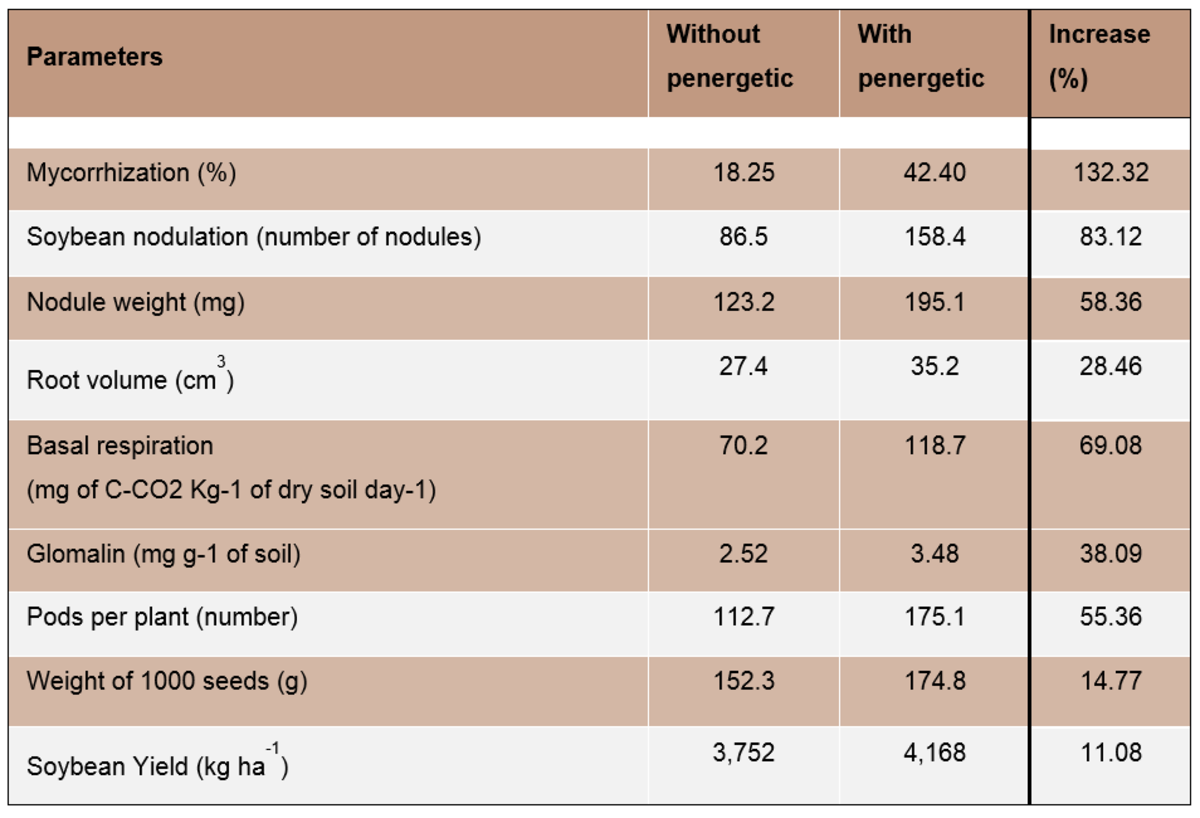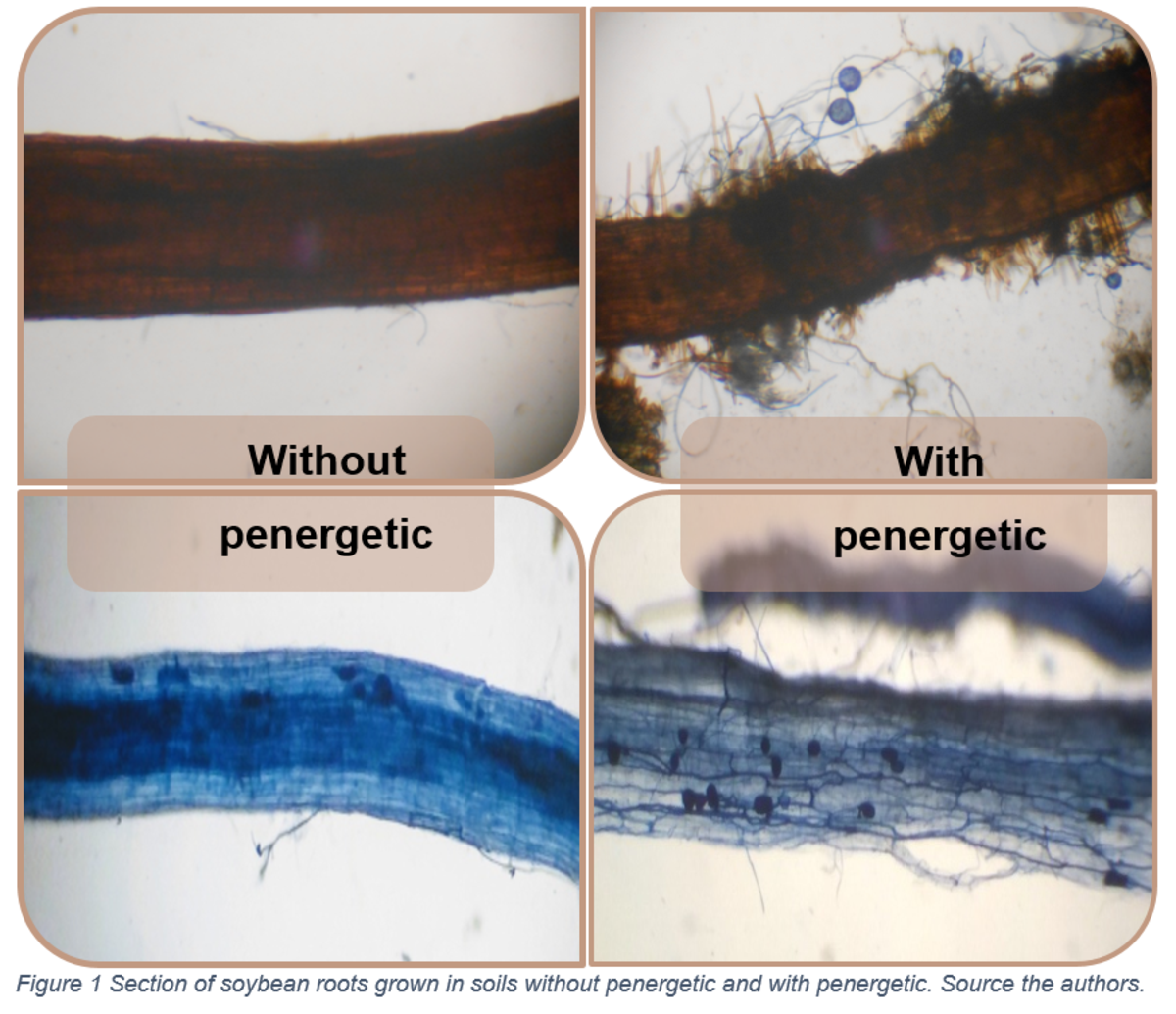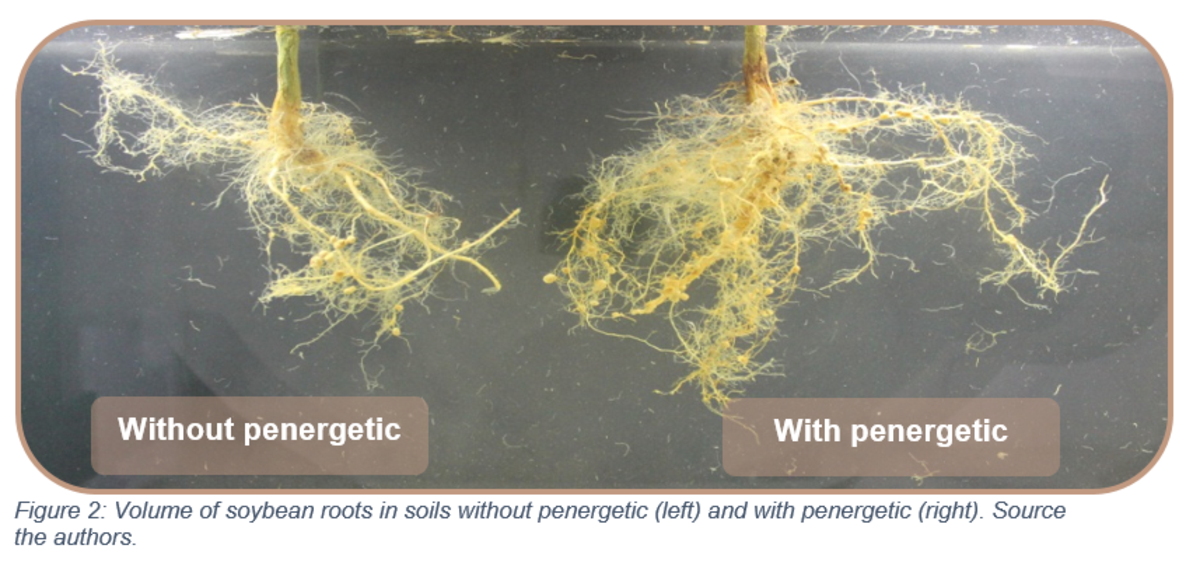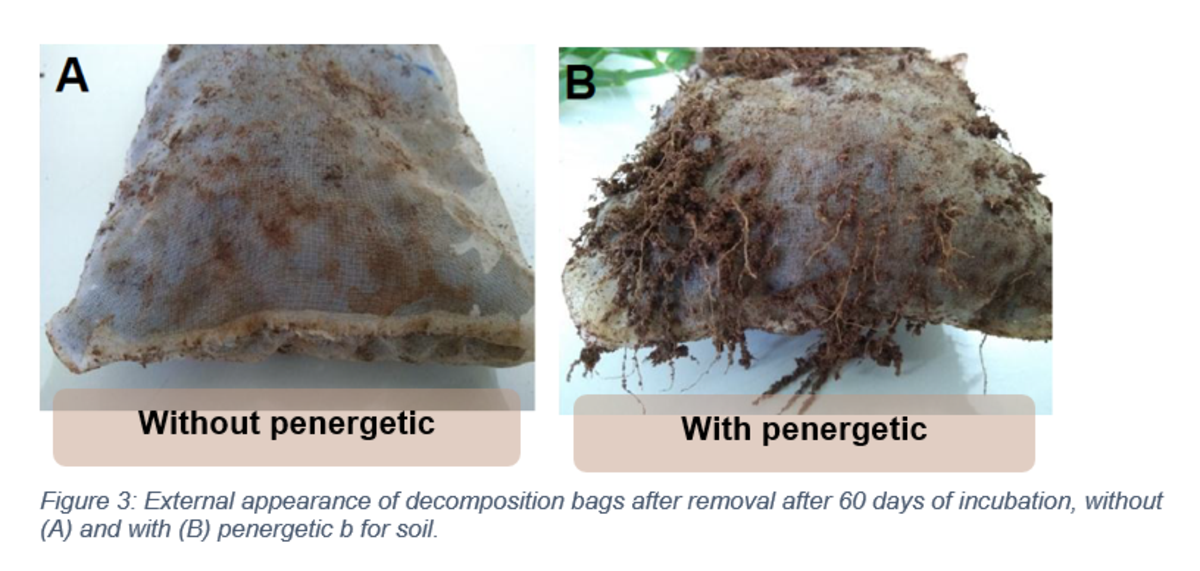
The importance of mycorrhizal associations for crop productivity
Ricardo Bemfica Steffen and Gerusa Pauli Kist Steffen
PhD in Soil Science
BRAZIL
Produkt/Product:
penergetic b (Art. N. 3000) and penergetic p (Art. Nr. 4000)
Datum/Date:
24.03.2020
Agriculture is experiencing a time of innovation to improve crop productivity
The agricultural world is constantly changing. The knowledge and understanding of ecosystems help to understand production mechanisms. Evolution is constant. Agriculture is experiencing a time of innovation to improve crop productivity. Climate change, productive challenges, the need to supply the population with healthy and abundant food, cause companies to innovate and increasingly use natural mechanisms to provide tools that provide clean agricultural production. In this context, one of the most important issues is the deeper knowledge of the soil and its biological interactions.
the soil is a living organism
Conceptually, “the soil is a living organism corresponding to the most superficial layer of the earth's crust, consisting of mineral and organic materials resulting from the interactions of the formation factors (climate, living organisms, source and relief material) over time, containing matter alive and partly modified by human action, capable of supporting plants, storing water, transforming waste and supporting buildings”.
When we say that the soil is a living organism, many are still surprised. But isn't the soil inert? Isn't it a mineral body? No, the soil is not inert. It is a three-phase system, formed by a solid fraction (corresponding to 50%), a liquid fraction (25%) and a gas fraction (the other 25%). And although most of the solid fraction of the soil is made up of minerals, approximately 5% corresponds to the fraction of organic matter. And it is precisely this 5% that represent the living fraction of the soil, fundamental for the production of plants, since it is responsible for the interactions that occur between plants, the soil and the climate.
There is a truth for those who work with the soil: “The biological fraction of the soil is fundamental for agricultural production”. And it is closely related to the maintenance of soil quality and the sustainability of agriculture, issues that have been widely discussed in recent years. And this is because many farmers realized that even when handling the chemical and physical issues of the soil well, the productivity indexes remained very similar and below the desired levels.
“It is important to understand that the high productivity of the crops depends on chemically balanced, physically structured and biologically active soils.”
The 3 pillars that support agricultural productivity:
- The chemistry or fertility of the soil
- The physics or structure of the soil
- Soil biology and microbiology
All parameters need to be considered. For example: it is not enough to nourish the plants well if the soil is compacted and does not allow the roots to grow. It is not enough to unpack the soil if we do not provide the 17 essential nutrients for the plants. It is not enough to supply the 17 essential elements for the plants and to decompress the soil if the microorganisms that will supply the structural organic compounds, that are also essential for plant growth, are not present. What are these compounds supplied by microorganisms? It is amino acids, phytohormones, organic acids, phytoalexins, which are, carbon chains essentials for plant development. If we are going to analyze the constitution of a plant, 96% is formed by the elements Carbon, Nitrogen and Oxygen. And where do these elements come from?
The environment and microbial interactions.
A lifeless soil is not able to support plant production
So, although the scientific community is not completely discovered all the action of the great diversity of organisms and microorganisms present in the soil, they play a fundamental role for agriculture and for the regulation of the main processes. These processes involving plant nutrition, such as nutrient cycling, decomposition of organic matter, the production of metabolites that stimulate plant growth (phytohormones), which act in the defense of the plant against the attack of pests, the nutrients absorption, the fixation of nitrogen from the air, the degradation of toxic compounds. Finally, a lifeless soil is not able to support plant production.
"Plants don’t have roots, they have mycorrhiza"
This sentence was pronounced decades ago by JL Harley in the book “Mycorrhiza and soil ecology” in order to alert ecologists and biologists to the fact that, under natural conditions, most plant species are associated with certain soil fungi in a mutualistic symbiosis of the mycorrhizal type. The fundamental role of mycorrhiza in plant production was discovered in the 19th century, in the year 1885, by the German scientist Albert Frank. The term comes from the Greek, where "myco" means fungus and "riza" means roots.
So, we know mycorrhizae as those species of fungi that associate with the roots of plants, through a totally beneficial association for both. About 90% of terrestrial plants form mycorrhizal associations.
The most important group for cultivated plants is the arbuscular mycorrhizae. This group have a system of exchange of assimilates present inside the roots. The so-called arbuscules and vesicles are structures formed in the root cortex and regulate the exchange of sugars and nutrients between the plant and the fungus. Arbuscular mycorrhizae are present in several agricultural crops around the world.
mycorrhizal plants are able to explore a much larger volume of soil in search of water and nutrients
Currently the farmers that are getting high levels of grain productivity, especially soybeans, beans, corn and sorghum, are working with managements and technologies that preserve soil biology, ensuring the maintenance of biological interactions in the system. Many of these managements aim at maintaining and increasing mycorrhizal activity in the soil. These effects can be confirmed by laboratory analysis by comparing the biological quality of the soil in an integrated management system aiming at increases in biological activity.
Arbuscular mycorrhizae are the mutualistic fungal associations that have been studied more recently. Approximately 150 species of arbuscular mycorrhizal fungi are present in agricultural soils and the symbiosis of these fungi with plants depends on a complex sequence of interactions, whose symbiotic relationship results in perfect morphological, physiological and functional integration.
In the field, there is greater growth and health quality of the plants that form mycorrhizal associations. These effects are related to the fact that mycorrhizal plants are able to explore a much larger volume of soil in search of water and nutrients (especially phosphorus), as the set of fungi hyphae acts as an extension of the root volume of plants, in addition to synthesize compounds that provide forms of nutrients that would be inaccessible to plants were it not for the action of fungi.
Greater water absorption and utilization in plants
In situations of presence of toxic elements in the soil, hyphae act to immobilize these elements, preventing them from being absorbed by the roots. It is also known that mycorrhizal fungi play an important biochemical signaling function for other symbiotic microorganisms in the soil. The fact that the root system of a cultivated plant is in symbiosis with certain mycorrhizal fungi guarantees the establishment of new associations and the maintenance of the biochemical processes in the rhizosphere. Even biological nitrogen fixation in soybeans and beans has interaction with mycorrhiza. Research papers demonstrate positive interactions between strains of rhizobia and some arbuscular mycorrhizae. These interactions result in greater efficiency regarding nodulation and effective nitrogen fixation.
In addition to these nutritional effects, research results have proven additional effects related to greater water absorption and utilization, production of growth stimulating phytohormones, protection of the root system due to hyphae act as a natural barrier to prevent the penetration of pathogens, and greater efficiency in the nitrogen fixation system by legumes. A variety of compounds and molecules, such as auxins, cytokinins, gibberellins, vitamins and bioactive organic compounds accumulate in greater quantities in mycorrhizal plants.
Table 1. Benefits of the Penergetic technology on soil quality and soybean productivity.

Note: These data were generated from field trials conducted in Brazil by Ricardo Steffen and Gerusa Steffen (2019/2020).
mycorrhizal fungus can supply up to 80% of phosphorus, 25% of nitrogen, 10% of potassium, 25% of zinc and 60% of the copper that the plant needs.
As for the nutritional effect, the external hypha of the arbuscular mycorrhizal fungus can supply up to 80% of phosphorus, 25% of nitrogen, 10% of potassium, 25% of zinc and 60% of the copper that the plant needs. Symbiosis with arbuscular mycorrhizal fungi can also be relevant in protecting plants against stress caused by excess salts, stresses caused by extreme heat or cold, drought or the presence of chemical contaminants in the soil.

The large majority of vascular plants are dependent on mycorrhizal association
The biological stimulus of cycles in the soil and increase of the symbiosis between microbial communities and the root system of plants results in the plant development stimulus. Rooting is an important result observed in areas that use penergetic in crop management. The entire enzymatic and hormonal complex and the diversity of organic acids found in the soil in greater concentration in areas with penergetic result in greater root development in cultivated plants. Large volume of roots is very important, especially when there is water deficit or heat stress.

Most vascular plants are dependent on mycorrhizal associations. In general, plants that depend on mycorrhizal associations are those that have thick or quite lignified roots.
Mycorrhizal dependence is calculated by the difference between the productivity of a specific culture that is mycorrhizal and that of non-mycorrhizal plants. The knowledge of this relationship is very interesting to understand the importance of maintaining mycorrhizal inoculum in agricultural soils. In plants such as manioc (Manihot esculenta), 98% of the productive potential is directly related to the quality of the established mycorrhizal associations. In other words, in soils without the presence of mycorrhizal inoculum, cassava production is unlikely.

Soy, beans, corn and sorghum crops are highly dependent on associations with arbuscular fungi.
So, we can classify the degree of dependence of plant species as very high, medium, low or even zero. Among crops of agricultural interest, rice, for example, has a very low dependence on mycorrhizal associations. Both in rainfed conditions and in irrigated cultivation, rice does not depend directly on this association. The soy, beans, corn and sorghum crops are highly dependent on associations with arbuscular fungi. These cultures will express their genetic potential if, among all the productivity factors that must be met, the mycorrhizal association has also been considered.
Winter crops such as wheat, barley and rye are moderately dependent. In these cultures, the mycorrhizal association is important from the point of view of controlling water absorption in certain soils.
crop rotation can significantly favor mycorrhiza
The different agricultural practices, normally used in production systems, directly interfere in the growth and multiplication of arbuscular mycorrhizal fungi in the soil and in their symbiosis with the plant. Practices such as: tillage (no tillage), pH adjustment, fertilization, annual crop rotation, forage or crops for green manure and rotation of cultivation systems, such as crop-pasture integration, increase the mycorrhizal fungi community in the soil and the occurrence of mycorrhiza and optimize the effects of symbiosis, benefiting agricultural production. On the other hand, when soil and crop management is inadequate, there may be a reduction in this community and a consequent reduction in the response of plants to the inputs used.
Among the various agricultural practices, it has been observed that crop rotation can significantly favor mycorrhiza. So, for each production system it is important and necessary to program the appropriate crops and cultivars and the type of rotation to be used. Some annual and cover crops as well as some forages have a high degree of mycorrhizal dependence. When used in a rotation system, these plants increase the community of native arbuscular mycorrhizal fungi in the soil and benefit from mycorrhiza, as well as the subsequent crops.
So, if we know that crops of great agricultural interest such as soybean, bean and corn are dependent on mycorrhizal associations, it is easy to understand that we must prioritize management that stimulates biological balance in soils. These managements must, fundamentally, use tools such as: crop rotation, efficient cover plants (presence of bioactive compounds), adequate and precise fertilization programs and phytosanitary control (avoiding the unnecessary use of chemical molecules that may negatively influence the population microbial soil.
The soil must be seen as a production unit all year round. Not just in the harvest period. That is why it is so important to plan and understand the processes that take place in the soil, the interaction with the different forms of life that inhabit the same system. Knowing these interactions, it is possible to improve the quality and productivity of crops, ensuring longevity and sustainability of the soil.